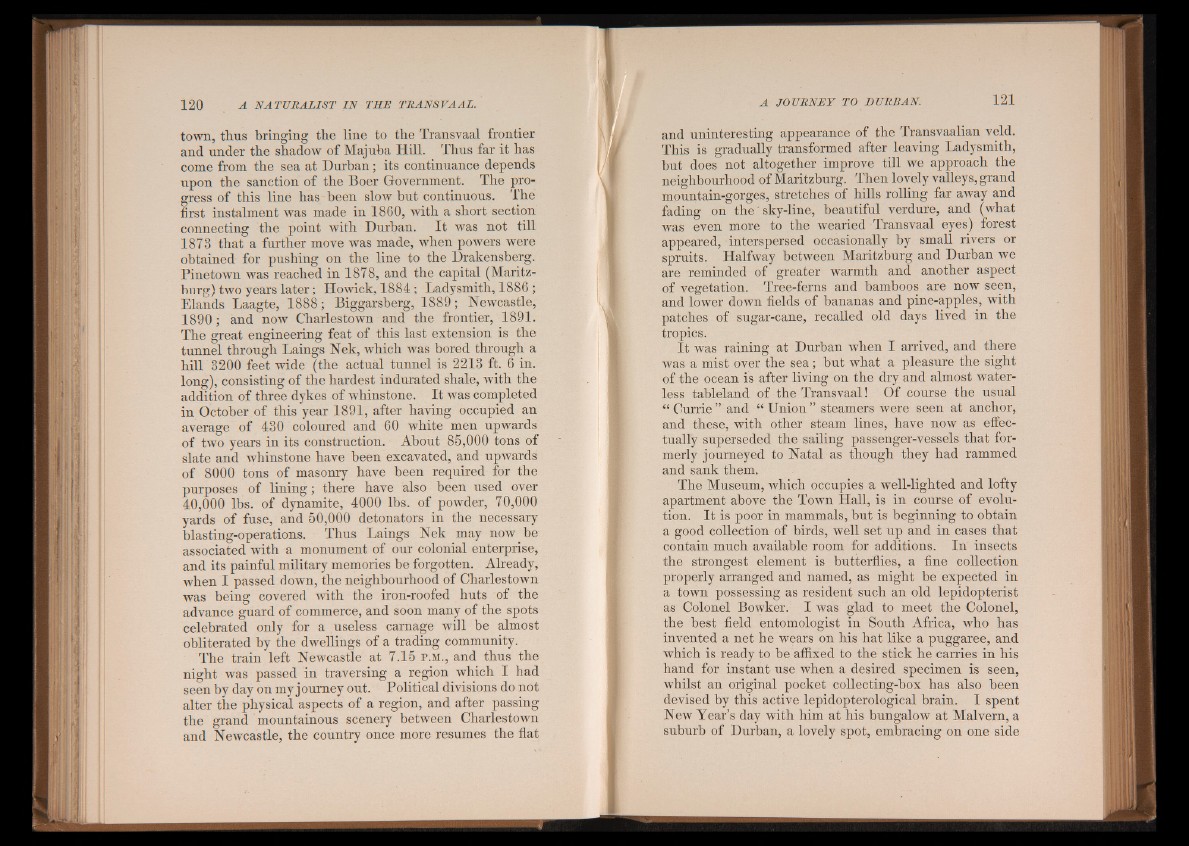
town, thus bringing the line to the Transvaal frontier
and under the shadow of Majuba Hill. Thus far it has
come from the sea at Durban; its continuance depends
upon the sanction of the Boer Government. The progress
of this line has been slow but continuous. The
first instalment was made in 1860, with a short section
connecting the point with Durban. It was not till
1878 that a further move was made, when powers were
obtained for pushing on the line to the Drakensberg.
Pinetown was reached in 1878, and the capital (Maritz-
burg) two years later; Howick, 1884; Ladysmith, 1886 ;
Elands Laagte, 1888; Biggarsberg, 1889; Newcastle,
1890; and now Charlestown and the frontier, 1891.
The great engineering feat of this last extension is the
tunnel through Laings Nek, which was bored through a
hill 3200 feet wide (the actual tunnel is 2213 ft. 6 in.
long), consisting of the hardest indurated shale, with the
addition of three dykes of whinstone. It was completed
in October of this year 1891, after having occupied an
average of 430 coloured and 60 white men upwards
of two years in its construction. About 85,000 tons of
slate and whinstone have been excavated, and upwards
of 8000 tons of masonry have been required for the
purposes of lining; there have also been used over
40,000 lbs. of dynamite, 4000 lbs. of powder, 70,000
yards of fuse, and 50,000 detonators in the necessary
blasting-operations. Thus Laings Nek may now be
associated with a monument of our colonial enterprise,
and its painful military memories be forgotten. Already,
when I passed down, the neighbourhood of Charlestown
was being covered with the iron-roofed huts of the
advance guard of commerce, and soon many of the spots
celebrated only for a useless carnage will be almost
obliterated by the dwellings of a trading community.
The train left Newcastle at 7.15 p.m., and thus the
night was passed in traversing a region which I had
seen by day on my journey out. Political divisions do not
alter the physical aspects of a region, and after passing
the grand mountainous scenery between Charlestown
and Newcastle, the country once more resumes the flat
and uninteresting appearance of the Transvaalian veld.
This is gradually transformed after leaving Ladysmith,
but does not altogether improve till we approach the
neighbourhood of Maritzburg. Then lovely valleys, grand
mountain-gorges, stretches of hills rolling far away and
fading on th e ' sky-line, beautiful verdure, and (what
was even more to the wearied Transvaal eyes) forest
appeared, interspersed occasionally by small rivers or
spruits. Halfway between Maritzburg and Durban we
are reminded of greater warmth and another aspect
of vegetation. Tree-ferns and bamboos are now seen,
and lower down fields of bananas and pine-apples, with
patches of sugar-cane, recalled old days lived in the
tropics.
It was raining at Durban when I arrived, and there
was a mist over the sea; but what a pleasure the sight
of the ocean is after living on the dry and almost waterless
tableland of the Transvaal! Of course the usual
“ Currie” and “ Union” steamers were seen at anchor,
and these, with other steam lines, have now as effectually
superseded the sailing passenger-vessels that formerly
journeyed to Natal as though they had rammed
and sank them.
The Museum, which occupies a well-lighted and lofty
apartment above the Town Hall, is in course of evolution.
It is poor in mammals, but is beginning to obtain
a good collection of birds, well set up and in cases that
contain much available room for additions. In insects
the strongest element is butterflies, a fine collection
properly arranged and named, as might be expected in
a town possessing as resident such an old lepidopterist
as Colonel Bowker. I was glad to meet the Colonel,
the best field entomologist in South Africa, who has
invented a net he wears on his hat like a puggaree, and
which is ready to be affixed to the stick he carries in his
hand for instant use when a desired specimen is seen,
whilst an original pocket collecting-box has also been
devised by this active lepidopterological brain. I spent
New Year’s day with him at his bungalow at Malvern, a
suburb of Durban, a lovely spot, embracing on one side